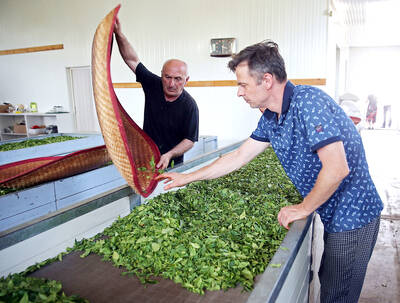After slowing this year, Asian economic growth could rebound next year as government spending and interest rate cuts spur demand, BNP Paribas SA said yesterday.
Asia, excluding Japan and China, is forecast to grow 4.3 percent next year after a 1.4 percent expansion this year, Richard Iley, an economist at the bank, wrote in a report.
Public spending in China, Taiwan and South Korea, combined with increasingly loose monetary policy, should help to drive a “reasonably vibrant” recovery, he said.
Asian governments are planning more measures to boost growth as a slump in global demand hurts exports, deepening the region’s economic slowdown.
South Korea has pledged about US$30 billion in extra spending and tax cuts since September. China may follow a 4 trillion yuan (US$585 billion) spending package announced in November with a second plan as early as this month.
“The scale of the global policy response — monetary and fiscal — should ensure the recovery is more V than U-shaped,” Iley said. “In many instances, economies will experience a 6 to 7 percentage point swing in growth rates.”
Iley’s report — titled Asia: Apocalypse Now — said that before improving, Asia’s economic growth would deteriorate this year.
“Global industrial production appears to have collapsed at a 30 to 40 percent annualized rate since September,” he said, referring to the “biggest demand shock since the 1930s.”
As a result of the drop in output, BNP Paribas cut its forecast for Asian economic growth last year to 1.4 percent from a November prediction of 3.9 percent.
The region comprises Hong Kong, India, Indonesia, Malaysia, Philippines, Singapore, South Korea, Taiwan and Thailand, according to BNP Paribas.
Iley said China is forecast to grow 7.7 percent this year, helped by the November fiscal package “worth an eye-popping” 14 percent of gross domestic product over two years.
The economy probably expanded 9.3 percent last year, slowing from 11.9 percent the year before. Iley predicted 8.1 percent growth next year.
Hong Kong is likely to grow 3.5 percent next year after shrinking 3.4 percent this year, the bank predicted.
Taiwan may expand 3.9 percent after contracting 3.3 percent; Singapore may grow 4.4 percent after declining 2.8 percent this year. South Korea may expand 3.2 percent, rebounding from a 2.4 percent contraction, the bank said.

UNCERTAINTIES: Exports surged 34.1% and private investment grew 7.03% to outpace expectations in the first half, although US tariffs could stall momentum The Chung-Hua Institution for Economic Research (CIER, 中華經濟研究院) yesterday raised its GDP growth forecast to 3.05 percent this year on a robust first-half performance, but warned that US tariff threats and external uncertainty could stall momentum in the second half of the year. “The first half proved exceptionally strong, allowing room for optimism,” CIER president Lien Hsien-ming (連賢明) said. “But the growth momentum may slow moving forward due to US tariffs.” The tariff threat poses definite downside risks, although the scale of the impact remains unclear given the unpredictability of US President Donald Trump’s policies, Lien said. Despite the headwinds, Taiwan is likely

When Lika Megreladze was a child, life in her native western Georgian region of Guria revolved around tea. Her mother worked for decades as a scientist at the Soviet Union’s Institute of Tea and Subtropical Crops in the village of Anaseuli, Georgia, perfecting cultivation methods for a Georgian tea industry that supplied the bulk of the vast communist state’s brews. “When I was a child, this was only my mum’s workplace. Only later I realized that it was something big,” she said. Now, the institute lies abandoned. Yellowed papers are strewn around its decaying corridors, and a statue of Soviet founder Vladimir Lenin

READY TO BUY: Shortly after Nvidia announced the approval, Chinese firms scrambled to order the H20 GPUs, which the company must send to the US government for approval Nvidia Corp chief executive officer Jensen Huang (黃仁勳) late on Monday said the technology giant has won approval from US President Donald Trump’s administration to sell its advanced H20 graphics processing units (GPUs) used to develop artificial intelligence (AI) to China. The news came in a company blog post late on Monday and Huang also spoke about the coup on China’s state-run China Global Television Network in remarks shown on X. “The US government has assured Nvidia that licenses will be granted, and Nvidia hopes to start deliveries soon,” the post said. “Today, I’m announcing that the US government has approved for us

UNIFYING OPPOSITION: Numerous companies have registered complaints over the potential levies, bringing together rival automakers in voicing their reservations US President Donald Trump is readying plans for industry-specific tariffs to kick in alongside his country-by-country duties in two weeks, ramping up his push to reshape the US’ standing in the global trading system by penalizing purchases from abroad. Administration officials could release details of Trump’s planned 50 percent duty on copper in the days before they are set to take effect on Friday next week, a person familiar with the matter said. That is the same date Trump’s “reciprocal” levies on products from more than 100 nations are slated to begin. Trump on Tuesday said that he is likely to impose tariffs